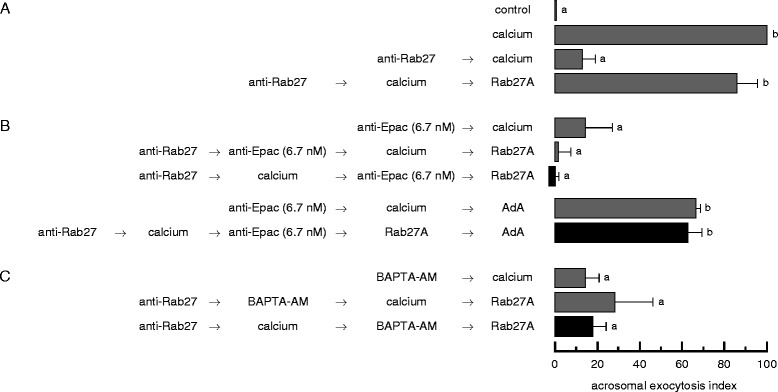Figure 3.

Sequestration of sperm Rab27 prevents subsequent calcium mobilization from the acrosome: results obtained with the reversible pair anti-Rab27 antibody (inhibitor 1)/recombinant Rab27A (inhibitor 1 rescue). SLO-permeabilized spermatozoa were loaded with 7 nM anti-Rab27 antibodies for 8 min at 37°C to block the signaling pathway where Rab27 is required. The AR was subsequently initiated by adding 0.5 mM CaCl2. After 8 min incubation at 37°C to allow exocytosis to proceed to the Rab27-sensitive step, sperm were treated with 6.7 nM anti-Epac antibodies (B) or 10 μM BAPTA-AM (C) and incubated for an additional 8 min at 37°C. Last, we added 14 nM recombinant GST-Rab27A (unprenylated and not loaded with nucleotides) to rescue the anti-Rab27 antibody block and incubated as before (black bars). When indicated, 5 μM adenophostin A (AdA) was added at the end of the series and samples were incubated for an additional 8 min. We run several controls in parallel (grey bars): background AR in the absence of any stimulation (control), AR stimulated by 0.5 mM CaCl2 (calcium), inhibition by 7 nM anti-Rab27 antibodies , 6.7 nM anti-Epac antibodies, and 10 μM BAPTA-AM; rescue of the anti-Rab27 antibodies by Rab27A; rescue of the anti-Epac antibodies by adenophostin A; and the inhibitory effect of the blockers when present throughout the experiment (anti-Rab27 → calcium → anti-Epac/BAPTA-AM → Rab27A). Sperm were fixed and AR was measured by FITC-PSA binding as described under Methods. The data represent the mean ± SEM of at least three independent experiments. Different letters indicate statistical significance (P < 0.001).
